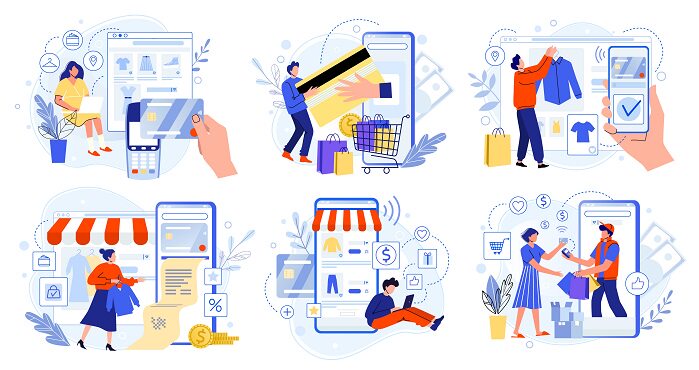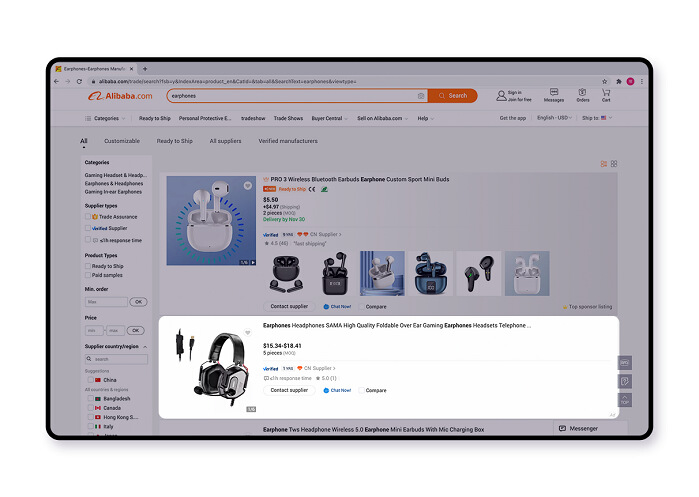Online Store Optimization: 10 Key Strategies - Alibaba.com

If you have an online store, you are a step ahead of many business owners. However, there is still a step to take: optimizing your online store for improved performance.
Will having an online store automatically bring traffic and sales? No. Will optimizing your online store position you for improved sales? Yes!
Optimizing your online store is the key to increasing your number of conversions and setting your business for success. In this article, we will introduce you to the key strategies for online store optimization. Let’s dive in.
Table of Contents
Introduction to online store optimization
Before you optimize your online store, you need to understand what optimization means and why it’s essential.
Online Store Optimization refers to all the steps and approaches taken to improve your website conversion rates. Generally, conversion rates are the sales you make through your online store. It is usually expressed as the percentage of people who purchased vs. the number of people who visited your store.
The average conversion rate on desktop, according to Statista, is 2.1%, and data shows that well-optimized stores have the best conversion rates.1
Importance of online store optimization
Some primary importance of e-commerce optimization include:
- Attract new customers
Data shows that more people are shopping online, so optimizing your store for online sales will improve your business’s standing in the digital space. 2 By optimizing your online store, you provide an accessible channel for people to shop from you.

- Improve your visibility on search engines
One of the ways you can improve your SEO and stand a chance to appear on Google’s search results is by optimizing your website. The more optimized your website is, the more likely your store will appear on search results when potential customers search for your products.
- Improve conversion rates
The primary importance of online store optimization is to improve your conversion rates. In other words: to sell more. Improving your online store optimization will get more people to buy from you through your store, boosting your sales and improving your business success.
Understanding the basics of online store optimization
Online store optimization aims to improve user experience by removing any friction that might prevent people from purchasing from your website. With a few tips and choices, you can provide a better shopping experience for your customers and increase your conversion rates.
Some basics to a successful online store optimization are:
- Keyword optimization
- Simplifying website design and navigation
- Improving user experience
- Developing compelling content
- Optimizing call-to-action
- Streamlining checkout process
- Getting insights through data analytics
Strategies for successful online store optimization
Here are some of the best online store optimization strategies that you can use to improve your conversion rates and sales:
1. Mobile optimization for online stores
In 2020, 71% of retail traffic and 57% of revenue were generated from mobile devices.3 Also, two out of every three dollars spent online is done via a mobile device.4
What does this mean for your business?
It means that anyone with an e-commerce store should optimize for mobile devices because that’s what most customers use to purchase online. Ensure that your website displays perfectly and that all the navigation works correctly on a mobile device. You can check your online site's mobile compatibility and responsiveness using tools like Google’s Mobile-Friendly Test.
If you need to improve your mobile optimization, consider crunching image sizes, removing irrelevant design elements, and reducing text on the website.
Tip: Optimize your store for use on devices like PCs to reach your customers efficiently and increase conversions.
2. Page load time
How sad will it be if customers find your online store only to leave without purchasing because it’s so slow?
A slow website will increase the bounce rate and reduce the number of people that stay in your store to purchase something. Your sales will be negatively affected if your store’s loading speed is slow, so it’s essential to improve it.
An online store that loads fast is essential for usability and improved sales. Before working on your website load speed, check out how fast your online store is. There are platforms like PageSpeed Insights that you can use to check your online store load speed.
If the speed is low, you can start optimizing by compressing large images and using a cache to store a version of your site on people’s browsers.
3. High-quality images and detailed product information
A great way to improve conversion rates is by sharing high-quality images on product pages. Show the products from different angles or use 360o images to help people get an accurate picture of what they are purchasing. It would help if you also allowed the zoom option to help potential customers see the product from different perspectives. If you have the opportunity, consider using videos to demonstrate your products to increase conversion rates.
Don't forget to add relevant product information to help people make informed purchases. You can add details on product size, key ingredients, uses, and any information that might be useful for a first-time customer.

4. User-friendly navigation and site structure
Optimizing an e-commerce store isn't just about the speed and images but also how functional your store is. Does your online store have a user-friendly design? Are the fonts clear and bold? Can people easily navigate to place an order?
Many customers often leave a website because the navigation and structure are confusing. Make navigation easy for your visitors so they have a clear direction of what to click to find what they are looking for. For example, having a search bar in a convenient location on your online store can increase the chances of customers ordering from you. Also, having a navigation bar will help visitors navigate between different pages on your website.
Another way to improve your website's navigation is by sorting products into different categories. You can sort into categories like usage, best-selling, number of orders, price range, color, material, and so on to help people quickly find what they need.
5. Invest in SEO strategy
Many e-commerce stores lose out on traffic because they fail to invest in SEO. An excellent search engine optimization strategy will increase your organic ranking, improve engagement, and increase your conversion rates. Some essential SEO strategies to focus on are:
- Keyword targeting
This involves identifying words and phrases your potential customers are looking for and incorporating them into your website content. Many free and paid tools help business owners identify relevant keywords.
- Visual assets
SEO also includes visual assets like images and videos. Avoid stock photos and invest in high-quality images.
- Title tags and meta descriptions
Customers and search engines should be able to understand everything written on your website, including page titles, headings, and meta descriptions. Ensure your page titles, product descriptions, and image alt are written in clear and compelling language. Stay away from generic descriptions and focus on developing original content.
- Internal linking
Link your pages to other internal pages on your website to improve SEO and sales.
Some other SEO strategies to pay attention to are URL optimization, content creation, image optimization, and geotagging.
6. Align your communication with your target audience
Personalization is essential to attract your target audience and increase sales. Ensure that your website's messaging and content are directed at a clear audience. To target a specific audience, you must first identify who they are, their demography, motivations, and pain points.
Write down all of these before you begin to write the content and copy for your online store.
7. Personalize users’ shopping experience
Besides targeting a general audience, you should also personalize individual shopping experiences. There are different ways to personalize customers’ shopping experiences, but one of the most common steps is offering product recommendations. You can suggest products relevant to your customers based on their previous purchases and what they add to their cart. Alibaba.com does this so well.
You can also use geo-targeting to suggest regional recommendations if you offer products in different regions. Another critical strategy for personalizing user experience is optimizing your online store in multiple currencies and languages to cater to a wide range of customers. For example, if you are selling to a global audience, an online store in English only might be a disadvantage to your business.
8. Make checkout convenient and easy
Optimizing your checkout process is an essential online store optimization tip to increase conversion rates. Ensure that nothing on your website will make things difficult for customers to order and checkout. You should also provide a guest checkout option so customers can easily get to the checkout page without creating an account. Some other tips to optimize your checkout page include:
- creating a summary page
- offering secure payment options
- displaying trusted badge
- adding a progress indicator, and
- allowing the option to preview order details.

9. Reminder emails about products left in the cart
It’s common for potential customers to add items to a cart without checking out or paying for them. If you have a high cart abandonment rate, you should consider sending emails to remind customers to check out. The more follow-up emails you send, the more likely customers will complete their purchase. You can also offer exciting deals and offers to encourage customers to visit the site and complete the order. Don't forget to add to the mail a call to action button that leads to your online store.
10. Track key metrics and adjust accordingly
The last tip for e-commerce optimization is tracking your success as often as possible and adjusting your online store to adapt to your customers’ needs and modern capabilities.
You can use analytics tools to track metrics like click-through rates, bounce rates, and conversion rates to see what’s working for you and what’s not. Also, tracking your performance can help you see areas you perform poorly and strategies to improve your online business.
You can also conduct A/B testing to gather users' feedback and make informed decisions when making changes to your website. For instance, you can test two identical pages with different CTA and use analytical tools to see which of the two CTA options is better.
Leverage Alibaba.com’s advertising tools to optimize your online store
Online store optimization leads to improved sales. Meanwhile, there is no doubt that optimizing an online store can be complex, especially when you are starting from scratch. This is why it’s necessary to leverage tools such as Alibaba.com advertising tools to optimize your store.
Alibaba.com advertising tools are designed to help online businesses improve their conversion rate optimization. Advertising your business will help you:
- Target and find new customers
- Improve your business and product visibility on search results
- Increase your reach and exposure on the platform
- Improve your conversion rates and sales
Some essential Alibaba.com advertising tools you can use to increase your visibility and sales include:
- Keyword Advertising (KWA)
This advertising tool allows sellers to bid and set up relevant keywords to position their business better on the website and mobile app. With Keyword Advertising, you can position yourself higher on search results by targeting specific keywords relating to your product category. Keyword Advertising is very cost-effective, and the best part about using it is that you only pay when a buyer clicks on your product.

- Premium Sponsored Ads
This advertising option enables businesses to rank consistently on the first page of search result pages. Using Premium Sponsored Ads is an effective way to stand out ahead of your competitors and give your products more visibility. Whenever a keyword related to your product is searched, you can rest assured that your store will appear to customers.
Alibaba.com’s Advertising Tools are open to all sellers on the platforms, and there are different pricing options to cater to all budgets.

Start selling on Alibaba.com
The e-commerce landscape is very competitive, and optimization is the secret to setting up your business for long-term success. As a seller, you should make the most of the opportunity to sell via Alibaba.com. Also, don’t miss the option to leverage the platform’s advertising tools to boost your conversion rates. If your goal is to increase the number of customers on your site, increase your sales, or expand your business, Alibaba.com is the pathway to reach that goal.
Getting started on Alibaba.com is free! All you need is to visit Aibaba.com, sign up as a seller, and take advantage of the advertising tools to optimize your store.
📌Read more:
References
1. https://www.statista.com/statistics/234884/us-online-shopper-conversion-rate-by-device/
2. https://sleeknote.com/blog/online-shopping-statistics
3. https://www.wolfgangdigital.com/kpi-2020/
4. https://www.oberlo.com/statistics/mobile-commerce-sales
Start your borderless business here
Tell us about your business and stay connected.
Keep up with the latest from Alibaba.com?
Subscribe to us, get free e-commerce tips, inspiration, and resources delivered directly to your inbox.















